|
Chemistry News Archive November 2011
|
Chemistry News November 2011
News of the year 2011 in the fields of chemistry and chemistry-related topics like biochemistry, nantechnology, medicinal chemistry etc.
Main focus: press releases, scientific research results and summaries of chemistry articles, that are published in chemistry journals.
Please send us a eMail to publish your press release here!
|
|
| | | Chemistry: |  |
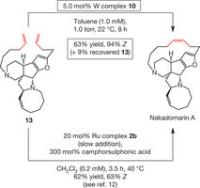 |
Highly selective catalyst developed for ring-closing olefin metathesis. International team led by Boston College researchers uses new catalyst to synthesize two potent anti-cancer molecules. Image: The total synthesis of nakadomarin A was realized through late-stage tungsten-catalysed ring-closing metathesis of the pentacyclic compound 13, and comparison with results delivered by Ruthenium catalysts [Credit: Nature DOI 10.1038/nature10563].
|
 |
Scripps research team achieves critical step to opening elusive class of compounds to drug discovery. Image: Elaboration of (+)-taxadienone (6) to (+)-taxadiene (7) by a three-step reduction-deoxygenation sequence [Credit: Nature Chemistry, DOI 10.1038/nchem.1196].
|
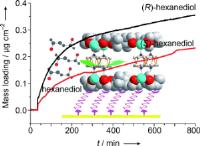 |
Researchers develop new process with porous molecular organic frameworks - relevant to the production of pharmaceuticals. Image: Preferred (110) and (001) orientation of enantiopure [{Zn2((+)cam)2(dabco)}n] ((+)cam=(1R,3S)-(+)-camphoric acid, dabco=1,4-diazabicyclo(2.2.2)octane) thin films can be controlled by carboxylate and pyridyl groups on self-assembled monolayers (SAMs) [Credit: Angewandte Chemie International Edition].
|
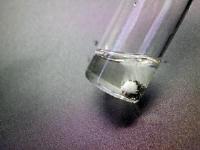 |
New material may boost efforts to convert gasoline infrastructure into one based on hydrogen. Image: Stored hydrogen releases in the presence of iron chloride via a storage technology created in the University of Oregon lab of Shih-Yuan Liu [Courtesy of Shih-Yuan Liu].
|
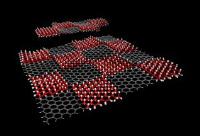 |
Graphene lights up with new possibilities: Rice researchers' two-step technique makes graphene suitable for organic chemistry. Image: Making a superlattice with patterns of hydrogenated graphene is the first step in making the material suitable for organic chemistry. The process was developed in the Rice University lab of chemist James Tour [Credit: Tour Lab/Rice University].
|
| | | Physics: |  |
 |
Caltech engineers reveal how scandium trifluoride contracts with heat. Image: The crystal structure of scandium trifluoride [Copyright APS].
|
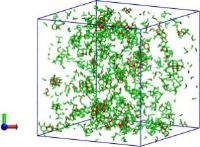 |
Utah chemists: Water doesn't have to freeze until minus 55 Fahrenheit. Image: The box here is full of liquid water, which is not shown (white). Supercooled liquid water starts to become “intermediate ice” (green) on the way to freezing into ice (red) well below the 32 degrees F that people normally consider water’s freezing point. University of Utah chemists calculated that supercold water finally must freeze at minus 55 F [Credit: University of Utah].
|
| | | Biochemistry: |  |
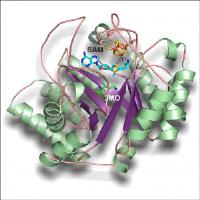 |
On the path to tailored enzymes: Enzymatic synthesis of pyrrolysine, the mysterious 22nd amino acid. Image: On the way to the production of pyrrolysine, an exotic amino acid occurring in only a few exotic organisms, the conversion of lysine to methylornithine is the decisive step. Scientists at the Technische Universitaet Muenchen succeeded in crystallizing the enzyme PylB which is responsible for this transformation and elucidated its structure. Top of the image: reactive center with an iron-sulfur cluster (red / yellow), the cofactor S-adenosylmethionine (SAM), and in the center of the image the product: 3-methyl-ornithine (3MO) [Credit: Felix Quitterer, TU Muenchen].
|
| | | Geochemistry, Astrochemistry: |  |
 |
Astrobiologists discover 'sweet spots' for the formation of complex organic molecules in the galaxy. Image: Methanol formation is the major chemical pathway to complex organic molecules in interstellar space [Photo courtesy of NASA].
|
|
|



